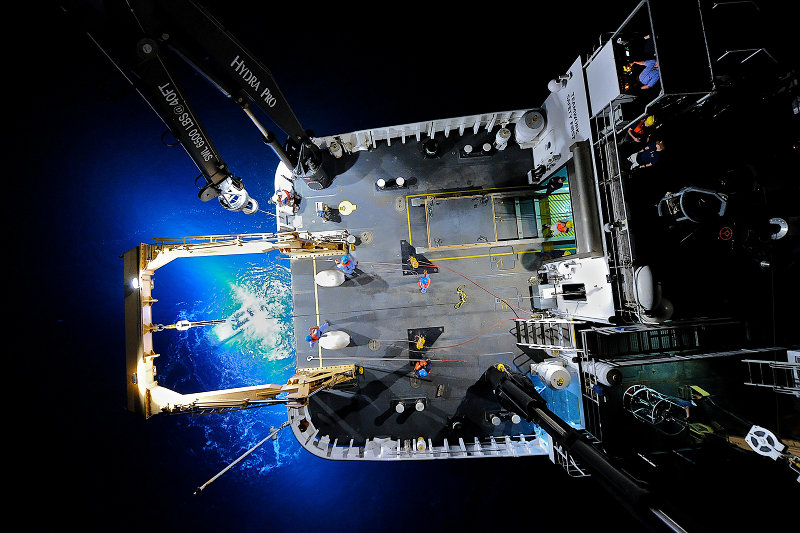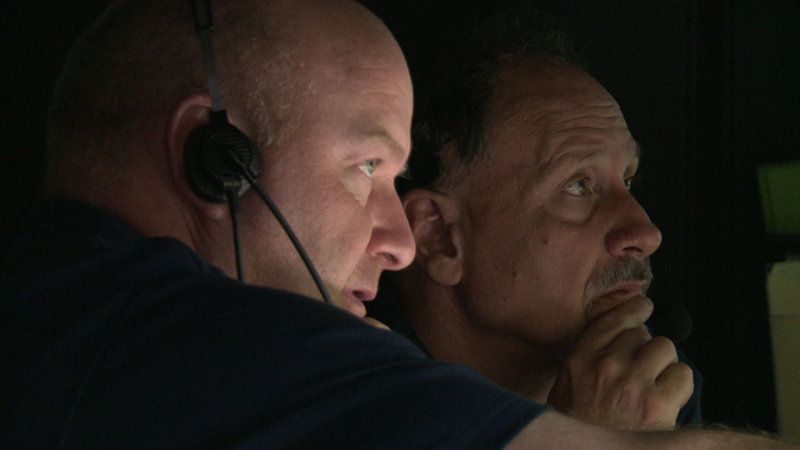
By Jeremy Potter, Expedition Coordinator - NOAA Office of Ocean Exploration and Research

A unique down-looking view of a ROV recovery at night. The underwater glow is created by the powerful lights on the Seirios camera sled. Image courtesy of the NOAA Office of Ocean Exploration and Research, Galapagos Rift Expedition 2011. Download larger version (jpg, 3.5 MB).
The Gulf of Mexico has been major a geographic focus for U.S. exploration and research for decades. While the large majority of past efforts have examined relatively shallow waters, a number of agencies and organizations have worked in deep areas. The National Science Foundation, NOAA, and Bureau of Ocean Energy Management (BOEM) have easily sponsored dozens of cruises. A long-term partnership between NOAA’s Office of Ocean Exploration and Research (OER) and the Bureau of Ocean Energy Management alone resulted in more than nine expeditions since 2004 (e.g., Expedition to the Deep Slope, and Lophelia II). Despite these important efforts, we often overestimate our fundamental understanding of the deep sea environment.
The critical need for even basic information about deep-water habitats in the Gulf of Mexico was frequently highlighted in the wake of the 2010 Deepwater Horizon accident. The purpose of this expedition is to help reduce that large unknown. We will focus on water column and deep unexplored diversity of benthic environments in the northern Gulf of Mexico region. We expect to explore cold seeps, deep coral communities, undersea canyons, shipwrecks – perhaps even mud volcanos and brine pools.

ROV Team Coordinator Dave Lovalvo and Science Team Lead Tim Shank discuss upcoming operations in the NOAA Ship Okeanos Explorer Control Room. Image courtesy of Joe Biscotti – NOAA Download larger version (jpg, 600 KB).
From March to April 2012, a team of scientists and technicians both at-sea and on shore will conduct exploratory investigations on the diversity and distribution of deep-sea habitats and marine life in the northern Gulf of Mexico. We expect to have a live-internet connection to allow the world public to ‘join’ the team in making real-time discoveries from hundreds to thousands of meters below the ocean surface. The 56-day expedition is divided into three ‘legs’ and includes operations in 1) DeSoto, Mississippi, and Green Canyon areas; 2) areas in the vicinity of the Deepwater Horizon site; and 3) the West Florida Escarpment.
Starting on March 03, scientists and technicians began mapping the seafloor using the multibeam sonar. From March 20, we will also explore seafloor habitats using the Institute for Exploration’s Little Hercules remotely operated vehicle (ROV) and the NOAA Seirios camera platform. The tentative schedule for the expedition is:
The NOAA Ship Okeanos Explorer is one of the newest additions to the NOAA fleet and was commissioned in 2008. It provides accommodations for up to 46 crew and technicians. Unique to this ship, however, is that most of the scientists will remain ashore. Via telepresence, live images from the seafloor and other science data will flow over satellite and high-speed Internet pathways to scientists standing watches in Exploration Command Centers (ECCs).
During this expedition, a subset of core scientists will work from the Silver Spring ECC in Maryland, University of New Hampshire ECC, the Inner Space Center at the University of Rhode Island, and a newly established location at the Stennis Space Center in Mississippi. In just the last month, we also have confirmation of scientists working from a number of other remote locations like Baton Rouge, LA; Houston, TX; Austin, TX; Galveston TX; Ft. Pierce, FL; Philadelphia, PA; State College, PA; Woods Hole, MA; and even the Netherlands. These scientists, and others on call if a discovery is made at sea, will add their expertise in real-time to operations at sea.
One of the hallmarks of this expedition will be the high-definition video provided from the Little Hercules ROV and NOAA’s Seirios camera platform. When deployed from the Okeanos Explorer, “Little Herc” and Seirios will provide scientists and the audiences onshore with the very first video footage from many of the deepwater areas in the northern Gulf of Mexico. All expedition participants are anxious to see the spectacular habitats and marine life we’ll discover.
This expedition provides unique and extensive opportunities to educators, students, and the public, bringing expedition-based materials and experiences directly into classrooms and to their fingertips. Education products specifically tied to the expedition include this website with content essays, daily mission logs, and imagery; near real-time ship tracking features; and standards-based Expedition Educational Modules complete with lesson plans and ocean career connections.
NOAA's Gulf of Mexico Deep-Sea Ecosystem Education Materials Collection includes a selection of lesson plans from previous OER-sponsored expeditions in the Gulf of Mexico and additional background information about the Deepwater Horizon event.